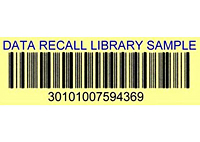
#Book barcode code
If you used the product code for each issue, that would get expensive. They need to buy the manufacturer and product codes. Publishers will use a unique product code for each title they publish and will be used for all issues printed under that title. The next set of five digits are the product code and created by a publisher.Publishers are assigned this code by the UCC council. The next five digits are the manufacturer code.5 and 9 are used only for coupons, or 2 is used for random weight items like fresh vegetables.) Comic book publishers will use 0, 1, 6, 7, 8, or 9, as certain numbers are reserved for specific uses. The very first digit denotes a UPC approved number system.The barcode found on US published comic books distributed through Diamond actually comprises five different bits of information. Here is the Anatomy of the Modern Comic Book Barcode and why this format is beneficial for publishers. There’s actually quite a bit of information contained in those 17 digits. Retailers and publishers across the country rejoiced! (Not really, but that’s for a different discussion) The UPC-A +5 format looks like this: This format was already being used by many of the major publishers but by making this the standard, smaller publishers could now have their sales and inventory tracked at retail. The format Diamond chose is what is known as the UPC-A Supplemental 5, or +5, format. As of January 2008, all comics distributed through Diamond had to contain a barcode in a specified format. In 2007 Diamond responded by introducing a barcode standard to be used on the comics you buy in your local comic book shop. In a early 2007 survey, Diamond Comic Distributors found that nearly 25% of retailers using a scanner system still had issues scanning barcodes. Well into the 00’s retailers had frequent issues with scanning barcodes. There also wasn’t an agreed upon standard or requirement for including a comic book barcode and many retailers ended up frustrated by being unable to consistently scan barcodes to improve their businesses. As a response, by the mid 90’s barcodes started to reappear on comic books destined for local retailers, but these were oddly different from the ones still found on comic books at newsstands. Comic books with barcodes essentially disappeared from the landscape.Īs technology became less expensive more accessible, smaller retailers started benefitting from using barcode scanners to help manage their sales and inventory. By the late 80’s the vast majority of comic books were being sold through local retailers. These new local retailers weren’t as technologically savvy and publishers found it easiest to just remove the barcodes. With the rise of the independent comic book shop in the late 70’s publishers needed to know the difference between books sold to newsstands and to local retailers. At the time this is where nearly all comic books were purchased so publishers started using early UPC codes in the mid 70’s. Newsstands and grocery stores were quick to adopt this new technology.


Look for a more in-depth article on the history of comic book barcodes in the near future.īarcodes have been used in the United States since the early 70’s and quickly became a common practice that allowed for easier and more efficient tracking of sales and inventory for businesses in most retail industries.
#Book barcode how to
Oh the insanity!!! This article gives a very brief history of barcodes on comic books but is primarily on how to interpret the modern comic book barcode in use since 2008. In some cases you could even have two copies of the same issue which have entirely different barcodes on them. Those that do can be confusing as they might have 13, 14, or 17 digits contained in them.


 0 kommentar(er)
0 kommentar(er)
